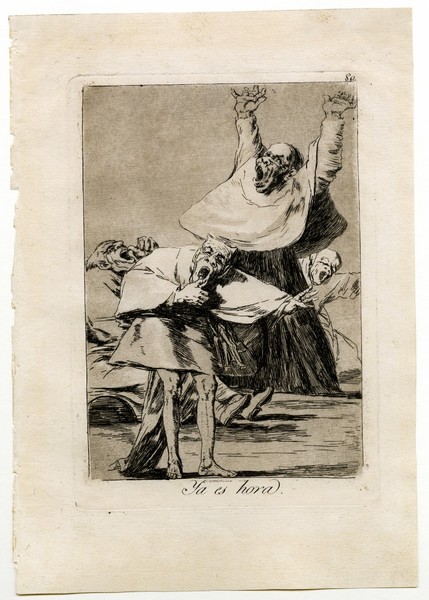- Cronología
- Ca. 1797 - 1799
- Dimensiones
- 217 x 152 mm
- Técnica y soporte
- Aguafuerte, aguatinta bruñida, punta seca y buril
- Reconocimiento de la autoría de Goya
- Undisputed work
- Ficha: realización/revisión
- 17 Jan 2011 / 29 May 2024
- Inventario
- 225
Ya es hora. (at the bottom)
80. (in the upper right-hand corner)
See Francisco de Goya y Lucientes, Painter.
The preparatory drawing for this engraving has not survived.
In the last print of the Caprices series, four friars are waking up, seemingly waking from their sleep. The one in the foreground holds a hand to his open mouth and shows his slender, knee-length legs. Behind him, another raises his arms and opens his mouth, as do the other two figures in the background.
The aquatint in this print is very soft and barely contrasts with the whites of the figures, while the burnishing is very fine. In the standing figure and in the background of the image, the burin touches can be seen.
In the manuscript in the National Library this engraving is explained as follows: "The bishops and canons, after sleeping soundly, get up late to go to mass; they yawn; they wait and think only of living a good life without working at all. They yawn, they wait and think only of having a good life without working at all. One of them wears on his cloak the sideburns and joints of the young boys who are spoiled by masturbation". The Prado manuscript states that with this image Goya suggests that the time has come to banish all the goblins, witches and beings of popular fantasy from this world in order to let reason awaken: "As soon as dawn breaks, witches, goblins, visions and ghosts flee, each to his own side. It is a good thing that these people can only be seen at night and in the dark! No one has been able to find out where they lock themselves up and hide during the day. Whoever managed to catch a burrow of Goblins and show them inside a cage at 10 o'clock in the morning in the Puerta del Sol, does not need any other majororazgo".
The Aragonese painter continued the criticism he had made in various prints from the series of The Caprices of the relaxed lifestyle of some members of the Church and their often licentious and reprehensible customs. At the same time, in this image he expresses his wish for the end of the superstitions in which a large part of Spanish society lived. These two aspects are not unconnected, but the second is conducive to the largely unjustified privileges of certain social sectors, especially the clergy.
The plate is preserved in rather poor condition (National Chalcography, no. 251).
-
Goya. Gemälde Zeichnungen. Graphik. TapisserienKunsthalle BaselBasle1953from January 23th to April 12th 1953cat. 258
-
Goya. La década de Los CaprichosMadrid1992organized by Real Academia de Bellas Artes de San Fernando sponsored by Fundación Central Hispano, Madrid, consultant editor Nigel Glendinnig. From October 26th 1992 to January 10th 1993cat. 186
-
Francisco de GoyaMuseo d'Arte ModernaLugano1996exhibition celebrated from September 22nd to November 17th.cat. 80, p.107
-
Ydioma universal: Goya en la Biblioteca NacionalBiblioteca NacionalMadrid1996from September 19th to December 15th 1996cat. 147
-
Francisco Goya. Sein leben im spiegel der graphik. Fuendetodos 1746-1828 Bordeaux. 1746-1996Galerie KornfeldBern1996from November 21st 1996 to January 1997cat. 86
-
Francisco Goya. Capricci, follie e disastri della guerraSan Donato Milanese2000Opere grafiche della Fondazione Antonio Mazzottap.52, cat. 80
-
Goya e la tradizione italianaFondazione Magnani RoccaMamiano di Traversetolo (Parma)2006consultant editors Fred Licht and Simona Tosini Pizzetti. From September 9th to December 3th 2006cat. 80, p.165
-
Goya. Opera graficaPinacoteca del Castello di San GiorgioLegnano2006exhibition celebrated from December 16th 2006 to April 1st 2007p.44
-
Goya e ItaliaMuseo de ZaragozaZaragoza2008organized by the Fundación Goya en Aragóna, consultant editor Joan Sureda Pons. From June 1st to September 15th 2008cat. 348
-
Goya et la modernitéPinacothèque de ParisParís2013from October 11st 2013 to March 16th 2014cat.13
-
Goya engravings and lithographs, vol. I y II.OxfordBruno Cassirer1964p.158, cat. 115
-
Vie et ouvre de Francisco de GoyaParísOffice du livre1970p.185, cat. 115
-
El mundo de Goya en sus dibujosMadridUrbión1979pp. 24-25
-
Goya, la década de los caprichos: dibujos y aguafuertesMadridReal Academia de Bellas Artes de San Fernando1992pp.306-307, cat. 186
-
Catálogo de las estampas de Goya en la Biblioteca NacionalMadridMinisterio de Educación y Cultura, Biblioteca Nacional1996p.116, cat. 172
-
El libro de los caprichos: dos siglos de interpretaciones (1799-1999). Catálogo de los dibujos, pruebas de estado, láminas de cobre y estampas de la primera ediciónMadridMuseo Nacional del Prado1999pp.392-395
-
ParísPinacoteca de París2013p. 71
-
Goya. In the Norton Simon MuseumPasadenaNorton Simon Museum2016pp. 42-75
